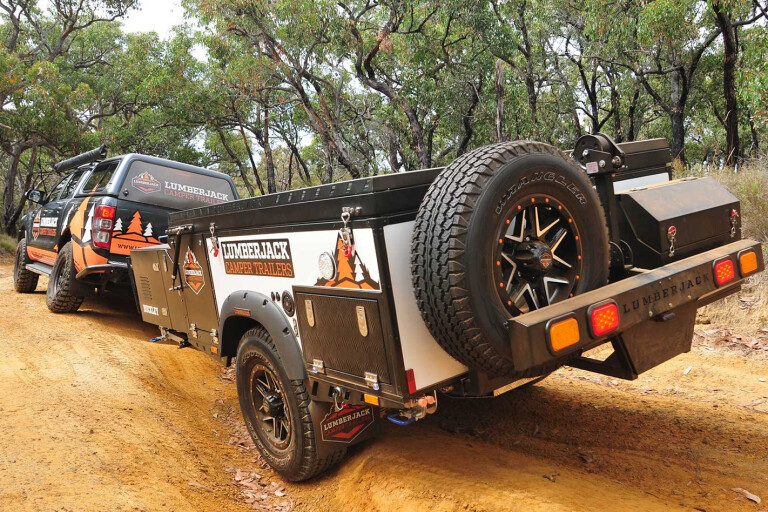
IT WAS a pleasant surprise to become associated with the Lumberjack brand.
Based in Geelong, Victoria, the family-owned business has been in existence for more than six years, growing from very humble beginnings to now housing a fine showroom showcasing the 17 models of camper trailers in its range. Varying in price from $22,000 to $60,000 (for its 17-foot dual-axle pop-top hybrid ’van) there is something that will suit the most ardent 4WD camper and caravanner.
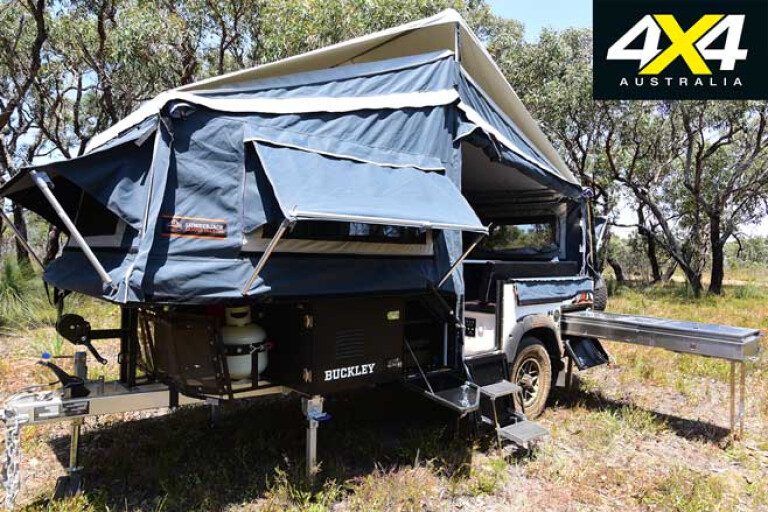
I checked out the workshop and factory where the campers and ’vans are first taken when shipped in from China. Here they are checked over, wired and plumbed to Australian standards, while the all-important A-frame is welded and bolted into place. The suspension is given the once-over with Aussie-sourced Dobinsons shocks fitted, and the tyres are upgraded to Goodyear Wranglers.
From its vast range we took the latest Lumberjack Buckley ‘Ultra Light’ for a spin, to see how it fared on some tracks in the northern part of the Otways. However, instead of the mud and bog holes the Otways are known for, we got dust and dust baths.
Like most of the campers in the Lumberjack range – apart from the bigger Birdsville model, which is a double-fold unit, and the somewhat quirky Sheoak, which is a pod-style camper – the Buckley is a forward-fold camper.
The lightweight Buckley features fibreglass-foam composite panels, which saves an impressive 200kg in tare weight and an equally important 100kg in ball weight over the standard Buckley model. Tare weight is 1120kg and the ATM is 1600kg, proving a healthy payload of just less than half a tonne.
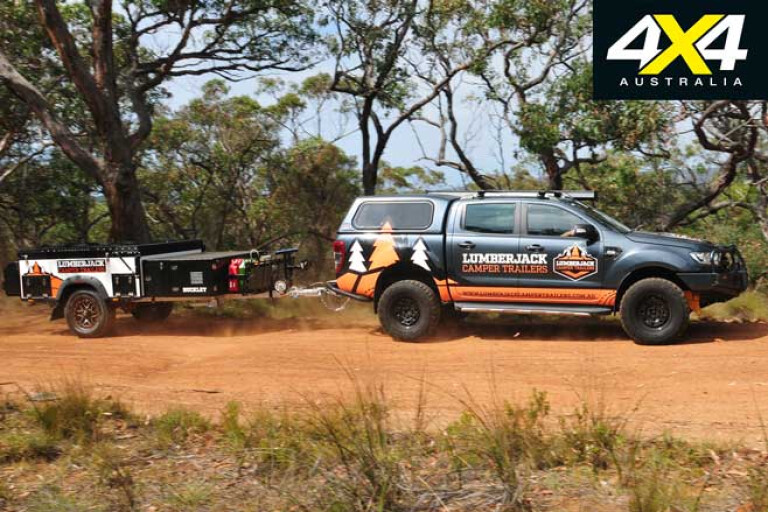
The chassis is hot-dipped galvanised steel, and the drawbar is made from 100 x 50mm 4mm-thick steel tube. The camper rides on an independent coil, trailing arm suspension, with dual Dobinson shock absorbers and 16-inch alloy wheels fitted with 285/75R16 Goodyear Wrangler MTR tyres. Axles are rated at 1600kg, while 12-inch electric drum brakes add ample stopping power and complete the wheel and suspension package.
The camper body is 2.1 metres long and sits essentially over the axle. This main box unit, where the tent, bed and living area are located (and is sealed away during travel) contains a slide-out kitchen on the near-side rear of the camper.
At the far end of the chassis is a spare-tyre carrier complete with a Wrangler tyre and a large storage box, which can store a host of wet, muddy equipment. A small hand winch for winding the camper closed is also included.
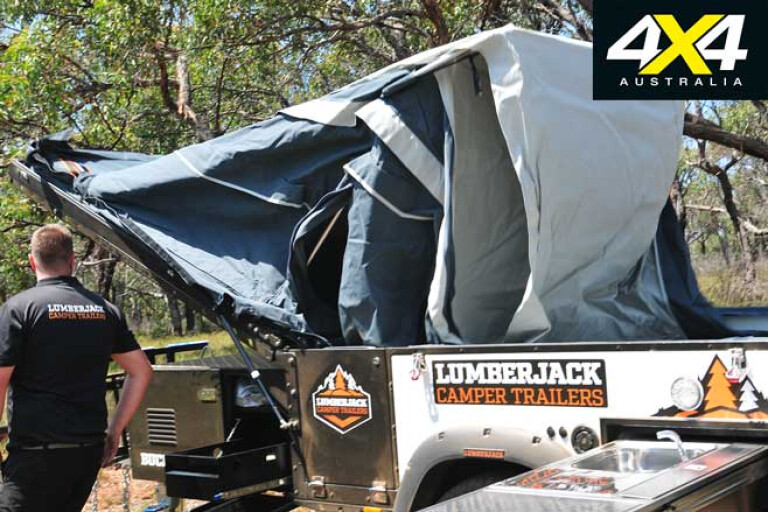
Another storage box is located in front of the main body of the unit, which is big enough to store a fridge or other similar items. In front of that again is an area for two 20-litre jerry can holders, two 9kg gas-bottle holders and a fuel tank for the standard-fitted diesel tent heater.
At the very front of the A-frame you’ll find a stone mesh guard to help protect all the stuff behind it, an Ark heavy-duty jockey wheel, a hand winch to help open the camper (rarely required) and a TREG-like off-road hitch; along with all the normal paraphernalia of chains and connection cables including an Anderson plug hookup.
Like most forward-fold campers – certainly all the ones I have seen – that A-frame is pretty long, giving an axle-to-ball length that can be an issue on tight 4WD tracks that dodge between trees, drop through steep creek gullies or climb over sharp knolls where the rampover angle can be a hindrance. Still, most people don’t take their camper into this sort of rugged terrain.
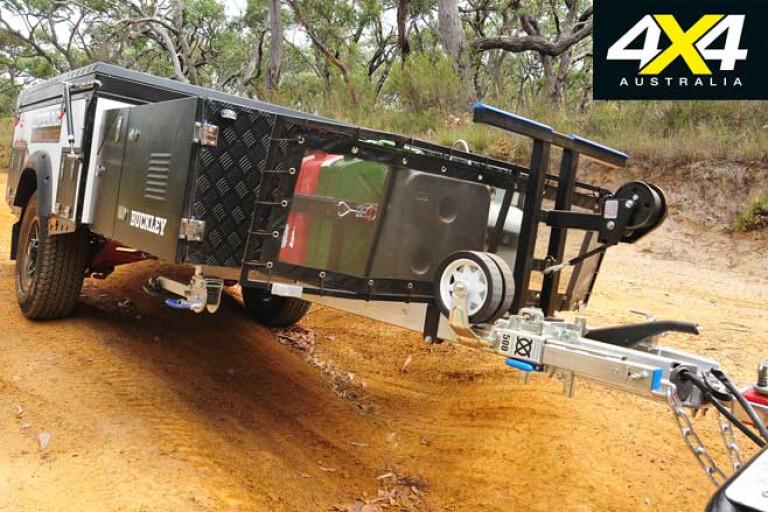
The slide-out kitchen is readily accessible for the shortest of stops, whether for a brew or an overnight stay. Once in position the kitchen has a large four-burner stove with some great windshields, which quickly fold up into place. Right beside it is a sink with a hot and cold water tap.
This slide-out kitchen has a couple of drawers for cutlery, cups and plates, with a storage area for items such as coffee and tea located behind the sink. Both the gas and hot and cold water hoses are attached by colour-coded, quick-and-easy connections.
To open the tent and living area of the camper simply unclip a few latches and give the lid of the main box a gentle lift, and the hydraulic rams will do most of the rest. This means the front winch gets very little use as the tent opens and the lid lifts over, becoming the floor and bed area of the set-up camper. Then open the door, unfold the step ladder and step into the camper. A few adjustments of the canvas and quick-release alloy tent poles from both inside and out, and the camper is ready for an overnight stop.
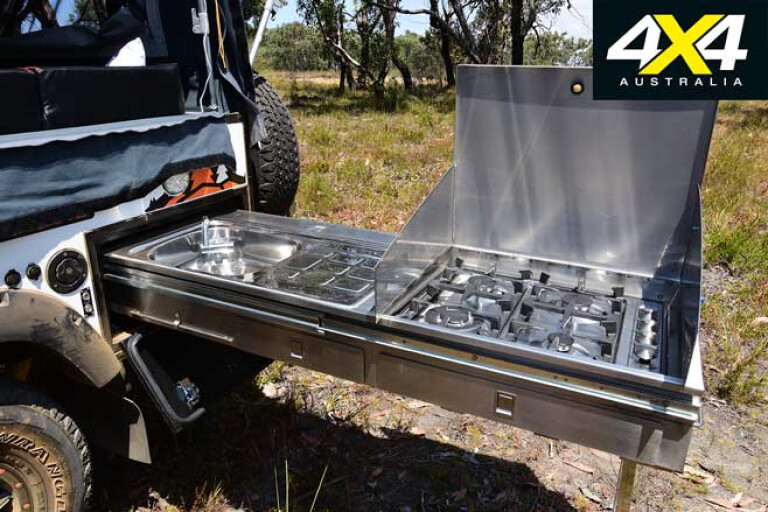
All the material in the tent area is 14oz waterproof canvas, with internal and external window covers in the main cabin area. Plus, all the mesh is midge-proof. In all, the canvas, mesh, zips and the sowing of the seams are pretty good, and while it isn’t Aussie-made or proofed canvas you would be paying a lot more for that privilege. Included in the canvas package is an outside awning, walls and a ‘tropical roof’, the latter being a godsend when it is hot, cold and/or raining.
As with many forward-fold campers, the canvas on the near side at the lounge end opens completely to provide a great airy feel and a fabulous place to sit inside while studying the view outside. The kitchen area includes a large U-shaped lounge around a sturdy drop-down table, giving ample room for four.
The lounge/table can be converted into another double bed, but I’d be sending kids or visitors to sleep in swags. The bed, which you need to step up into, is a full queen-size unit and comfy. With all the windows open the camper has a very light and open feel to it.
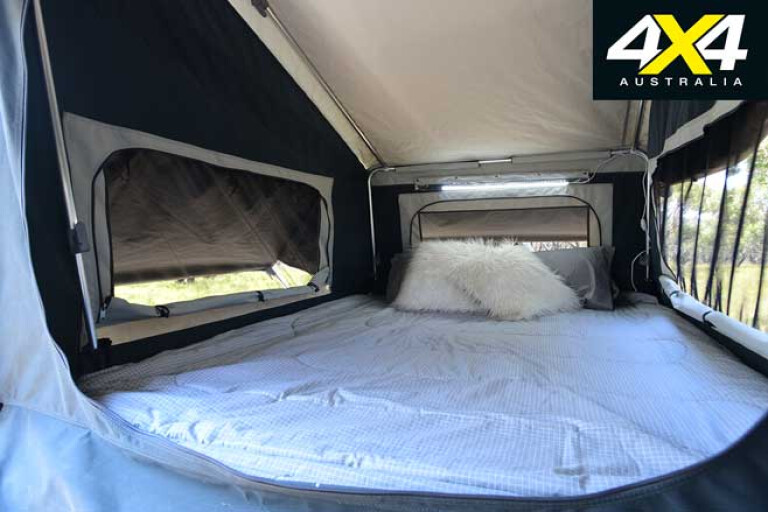
We didn’t set up the awning and walls but it’s a relatively easy zip-on job; although, it takes five to ten minutes longer and you wouldn’t bother if you were stopping overnight and the weather was fine. The walls and floor take longer again but make for an ideal setup for those longer beach or lakeside stays. Packing down the camper takes a little longer, but 10 to 15 minutes from the basic set-up should see you back on the road.
The camper’s electrics are pretty basic – the way I like my electrics, to be honest. You have 240-volt power input and a battery charger, which keeps the single 12-volt deep-cycle battery charged when it’s not getting fed by the tow vehicle or by an optional solar panel. The battery runs the lights, water pump, 12-volt power outlets, USB outlets and the multi-media player. There’s a control panel and water and battery monitor inside the camper, while inside the battery box is a circuit breaker and master switch accessed from either inside or out.

There are the two gas-bottle holders up the front, and the camper trailer is plumbed in to Australian Standards, with gas connections for the gas stove and the gas hot-water system. A diesel heater is also located in one of the storage bins below the lounge seat, and it is just the thing for wintery camps.
We took the camper along a variety of highways, second-class bitumen roads, gravel-graded roads and dirt tracks, and the camper towed easily and effortlessly uphill and down dale. The camper was hardly felt on the open road, due to its light weight and low profile. In the rougher stuff, where dirt tracks turned lumpy and were chewed up, the trailer followed very well, with the independent suspension keeping all wheels on the ground and the ride as smooth as possible.
Only once did the rampover angle, due to the long draw bar, cause the A-frame to drag as the camper mounted a particularly steep pinch. Most camper trailers would exhibit the same characteristic, with only those with very short A-frames capable of negotiating such obstacles with aplomb.
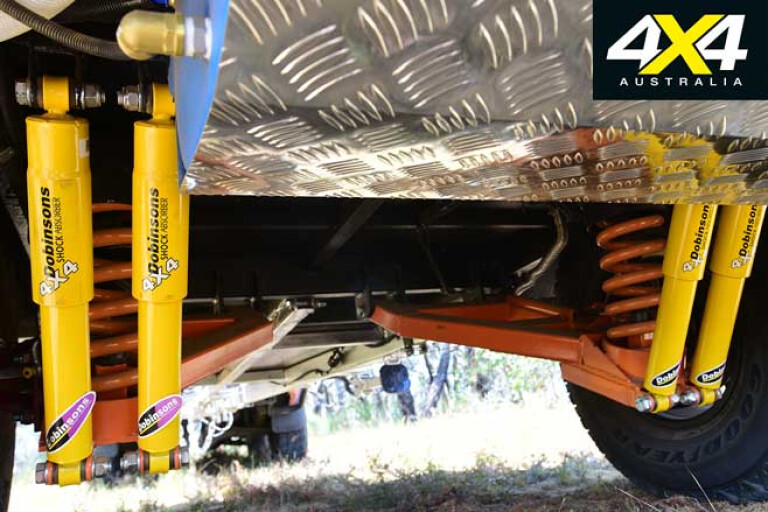
I’m a fan of this style of camper; the way it works and the features it offers … for what is a very good price. That being said, this price range and style of camper is now dominated by Chinese-sourced products, with the only variation being how well it is built in the particular Chinese factory it comes from, and how much Aussie input and accessories goes into the finished product.
The Lumberjack brand seems to be better built and better thought-out than many you’ll find on the Aussie market, with its Geelong factory, where much of the assembly takes place, adding another positive to the equation.
At $24,000, this unit should definitely be on your ‘go to’ list if you’re in the market for a forward-fold camper trailer. You’d be pretty pleased with the choice, I reckon.
Lumberjack Buckley Ultra Light specifications

HEIGHT (AT TRAVEL): 1500mm
WIDTH (EXTERNAL): 1850mm
LENGTH (OVERALL): 5400mm
TARE: 1120kg
ATM: 1600kg
BALL WEIGHT: 120kg (unloaded)
STORAGE: 7 external storage areas; 2 internal compartments under seats
BODY: Fibreglass-foam composite
CHASSIS: Steel, drawbar 100x50x4mm tube; all hot-dipped galvanised
ROOF: 14oz canvas with tropical roof
TENT: 14oz canvas and midge-proof mesh. Awning, tropical roof & annex flooring
SUSPENSION: Independent coil, trailing arm suspension with dual Dobinson shock absorbers
BRAKES: 12-inch electric drum brakes
WHEEL/TYRE: 16-inch alloy with 285/75R16 Goodyear Wrangler MTR tyres
FRESH WATER: 100L
BATTERY: 12V deep-cycle lead acid
ELECTRIC: 240V input; 12V power and USB outlets; LED lighting strips inside and out, multi-media stereo player, power and water monitors. 240-volt Firefly battery charger included
SOLAR: Optional
HOT WATER: Firefly instantaneous hot water
GAS CYLINDERS: Two 9kg gas bottle holders (gas bottles extra)
COOKTOP: Four-burner gas stove
FRIDGE: Optional
LIGHTING: 12V LED
PRICE: $23,999
Contact
Lumberjack Campers:
1300 30 40 45; www.lumberjackcampertrailers.com.au
Showrooms locations:
- Geelong, Vic
- Slacks Creek, Qld
- Newcastle, NSW
- Cameron Caravans of Edwardstown, South Australia

COMMENTS